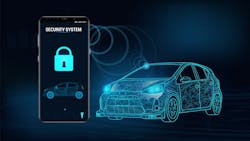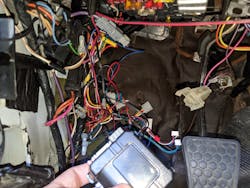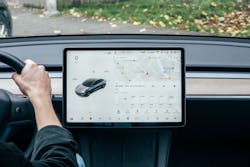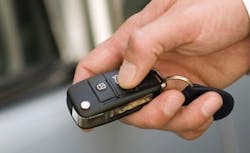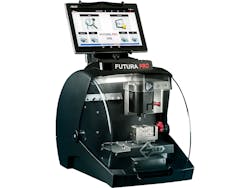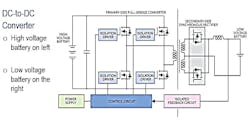I remember my first car just like it was still sitting in my driveway. It was a $50 1970 VW Beetle that had caught fire, burning most of the harness in the front trunk. I rewired it with spools of cheap stranded wire purchased from Murphy Mart, and it was a great learning experience for this 14-year-old. I spent the next year "polishing" this pile, but boy was I proud of it. Once running, I installed a radio, 14" tires (taken from a Buick that rubbed the fenders if anyone rode in the back seat) and white seat covers from J.C. Whitney. I loved that car. There wasn't a weekend that I didn't fix, break, or add something to it, so eventually, I ran out of common-sense things to do and decided I needed to have an alarm system. (FIG1)
For those of us who cut our automotive teeth in the early 1980s, you'll remember these systems. They came in a box full of wire and an installation manual that couldn't be more confusing if the sellers wanted it to be. I spent months trying to get at least the basic functionality operational but spent more time repairing the damage the installation was creating, rather than enjoying what the system could provide for me. My friends nicknamed the beetle "Kraco." (FIG2)
That was then, this is now
Aftermarket alarm systems have improved immensely since those early days, and they are still a part of the automotive upgrade pathway but most are now installed by professionals that have an understanding of modern vehicle electronic systems and know how to integrate a third-party alarm correctly. However, the market for "aftermarket alarms" has significantly decreased because new vehicles (more often than not) have integrated security mechanisms from the OEM.
Even the most basic cars and trucks produced today have immobilization and tamper sensors to protect them from content-theft or vandalism, and these OE offerings have gotten very complex. If you haven't stumbled across it yet, check out the YouTube videos on Tesla cameras, capturing vandals and parking mishaps being automatically recorded with its industry-leading security and autonomous systems. Of course, the more complex the system, the more significant the viability for a service opportunity.
Alarms available from the aftermarket continue to evolve to keep up with OEM development. Integrated with autonomous (ADAS) systems, vehicle security will continue progression into a viable but complex network of sensors, cameras and controls, reporting data locally and into cloud-based computing options.
The modern OE alarm system had an extensive development phase, with incremental steps along the way to improve the offering. For example, GM vehicles have had five different vehicle deterrent systems, each requiring its own set of procedures to be followed for diagnostics and repairs. Take that number and multiply it by the number of vehicle manufacturers, and you'll get an idea of the variety of systems out there, increasing the challenges faced by the technician.
It is also surprising how many consumers have no idea of the capabilities of their vehicle's advanced factory systems and are often challenged to know whether they have a security system at all. Confusion can begin with a misunderstanding of the key fob. Just because a vehicle has a fob with a "Lock and Unlock" function, it does not guarantee that an alarm system exists.
The owner's manual in the glove box with all the important operating procedures is a resource that could determine a vehicle's alarm existence and capabilities very easily. Most likely, the manual is unopened or possibly missing altogether.
Many incorrectly assume that their vehicle also has an alarm because they have a keyless entry system. If the fob has only two buttons (lock and unlock), chances are the car does not have a system.
An easy way to test this is to roll down the window, turn the car off, get out and lock the doors. After a minute or two (to assure any alarm has been activated), reach in the open window and attempt to open the door. Then, if the vehicle is equipped with an alarm, you'll know it.
Another way to determine this would be to look for a flashing light on top of, or on the face of the dashboard of a locked vehicle. This flashing light shows you that your vehicle's alarm system is armed and should be somewhat of a deterrent to thieves (as they most likely recognize what that beacon represents). This light can also be helpful to show the status of your alarm system, as most will illuminate a solid light when the vehicle is in operation to show an error in the system (as opposed to a flashing light).
Of course, the most common-sense thing to do would be to allow a repair professional to examine the vehicle and determine its alarm capabilities. If necessary, the vehicle owner can then decide if installing an aftermarket system is right for them.
OE and aftermarket systems both can offer similar functionality. It can be difficult to remain one step ahead of well-heeled thieves, but a modern alarm system can give you a fighting chance. Of course, the more complex the system is, the larger the challenge for the diagnostic and repair technician.
Let's start the discussion by listing the most popular alarm system features that can be present on an alarm-enabled vehicle. (FIG3)
1. Keyless remote: The remote is pretty self-explanatory, whether integrated into a key or as a stand-alone fob.
2. Immobilizer: Don't you love a system whose name states precisely what it does? The immobilizer… immobilizes. Tied directly into the vehicle's ECU, the immobilizer signal, which originates from the key fob, prevents the car from starting if the fob is not within range or the correct one for the vehicle.
3. Vehicle tracking system: Modern alarm systems can feature strategies that help recover a stolen vehicle through satellite GPS tracking.
4. Cameras: OEs are integrating cameras into their vehicle networks. Not just for ADAS but also security. Tesla, the General Motors Surround Video Recording System, and others are pioneering video systems that perform multiple duties.
These include driver situational awareness, safety systems, and vehicle security. Designed to start recording when there is vehicle movement, or in some cases, exterior activity, is detected by proximity sensors. These cameras can record and stream live video to the vehicle owner's smartphone.
5. Anti-snatch mode: A relatively new system, anti-snatch functionality takes advantage of the ability to pair your smartphone with your vehicle (FIG4. See above). This connectivity allows for a host of consumer-friendly tasks such as proximity lock/unlock and shared data service, but anti-snatch is perhaps one of the most intriguing.
With anti-snatch enabled, a running vehicle will automatically shut down after a user-defined period once the connection between the phone and vehicle are out of range of each other. This helpful feature is attractive in today's concerns over carjacking, and those scenarios where you only left the car running for a minute while you ran into the store.
6. Anti-theft mode: A close relative of Anti-snatch, Anti-theft works the same way. With the vehicle security system activated, the car or truck will not start unless the connection between the phone and the vehicle is active.
Repairing a faulty alarm system (whether OE or aftermarket) can be a challenging docket. We all recognize that systems are integrated rather than stand-alone, building challenges for diagnostics. A good example happened to a friend of mine who has a successful independent shop. He was asked why a client's Adaptive Cruise Control didn't work correctly. In addition, the OE alarm occasionally gave a false warning.
His scan showed many calibration errors of vehicle sensors, and a visual exam showed signs of a recent front-end collision repair. He queried the client, who stated that the front bumper cover had been replaced due to a parking incident a month before. A call to the collision shop that performed the repair showed that no recalibration of sensors had taken place after straightening a grill brace and the replacement of the bumper cover.
Diagnostic steps for OE alarm systems always start with your scan tool. Factory service data and TSBs are also essential resources for system repair, but of course, if the issue is rooted in an aftermarket system, all bets are off. The best recommendation I read was one from a well-known automotive instructor that said this:
"Figuring out what is wrong with a stereo-shop alarm system has to start with disabling the entire system, then reactivate/install each system and sensor individually till the problem shows up."
He has over 40 years in the industry, and I trust what he says.
Another great place to begin when dealing with an alarm system error is the basics, such as issues originating with the fob (FIG5). Is the consumer accidentally creating a problem by having the vehicle's fob bouncing around in the bottom of a purse or briefcase? Perhaps the fob's battery is low or loose in its socket, creating an intermittent issue.
Another common but easily diagnosed root cause could be a door, trunk, and hatch sensors. These latches get heavy use, are exposed to the elements and can create alarm issues. A savvy tech should check for door/latch alignment, clean and lubricate and verify the functionality of the sensor contact points.
Perhaps the fob or the alarm system is looking for a reset. Fobs generally require a scan tool for reset, but you may get good results by disconnecting the vehicle’s 12-volt battery for a minute or so. Don’t forget to check the alarm fuse.
For aftermarket systems, the next step would be with the wiring. If the original installation manual is not available (it likely won't be), use the web as a resource for the documents that came with the system. and don't forget to check any warranty that may exist from an aftermarket installer. Some shops offer attractive warranty periods, and even if it is out of their service window, it can still be a helpful resource.
OEM anti-theft system failures can be highly troublesome to diagnose without dealer software. However, it is not impossible. When analyzing the issue, a technician will use a computerized scan tool to observe conditions within the anti-theft system, identify where the miscommunication originates and service that portion of the system.
For instance, if the body control module receives correct information to signal the engine control module to start the vehicle, the engine should start. However, if it does not signal the engine control module to start the car, the circuit, body control module, and engine control module will need to be tested/isolated to find which component is failing to interpret data.
This can be a long and challenging process when intermittent issues are present. In some cases, an independent shop without factory scan tools may need to reach out to the dealership for assistance.
Another service opportunity for techs and shop owners is vehicle keys. Keys get lost, preowned cars arrive with only one key, keys stop working and only the savviest user will attempt to rectify a key issue on their own. Due to the structure of today's keys and fobs, it takes a trained technician with certifications and the right tools to assist the customer with this problem but offering this service isn't as expensive or complex as you would think (FIG6).
Key programming and cutting are viable ways an automotive shop can create a new revenue stream. For those in the market, there are surprisingly complex, yet reliable equipment that allows independent shops to cut and program keys for all makes of vehicles and for OE establishments to offer the same services for cars outside of the makes they sell. However, a few steps need to be followed for those new to this service.
First, the ability to access key, immobilizer, and vehicle PIN codes aren't just handed out to everyone for obvious reasons. To start down the key and fob programming path, a shop needs to acquire Secure Data Release Model (SDRM) credentials through an organization called the National Automotive Service Task Force, or NASTF (FIG7).
The folks at NASTF provide credentials for locksmiths and auto repair technicians who need access to vehicle security information (generally key codes and or immobilizer codes). Techs can apply for a 2-year Vehicle Security Professional credential by undergoing a background check and providing documentation that establishes their identity and business in their community. All the details can be found at nastf.org.
It is free to become a member of NASTF. It is a relatively quick and painless process, and Donny Seyfer and the folks at NASTF are top-notch and will assist with the process. Once the certification is completed, the remaining key and fob service steps to get you up and running are purchasing and training on key cutting equipment and unprogrammed keys and fobs.
I did a study at a previous place of employment on the estimated cost to get into this field, and the return on investment was surprisingly attractive. Based on investment in tools, machines and key fobs (of around $8,000), as well as the average industry charge to the consumer of $200 per key, the payback on the investment would be about 40 clients.
Compare that with how many alignments are needed to pay for that new rack you installed last year. I recently saw a Google ad that my local Ace Hardware franchise offered vehicle key cutting and programming. If your local hardware store thinks it is a good move to provide this service, it makes sense that it would work for you, too.
So, what is the future of alarm systems? A study by Future Market Insights states that the car security system market will surpass $33.8 billion by 2031 to coincide with the predicted rise in car theft cases. They further note that there was an almost 10% rise in auto thefts from 2019 to 2020 and expect an even more significant jump once the data from 2021 is compiled.
For the automotive technician, security systems are much like the growth of ADAS: Technology and the need to understand how to diagnose, repair and calibrate will become a necessity rather than an option in the tech's toolbox of skills. Jumping on board this train is no longer an option but rather a means of survival. Seeking training on automotive networks and integrated security systems will soon be a "must-have", rather than a "nice to have" skill.
